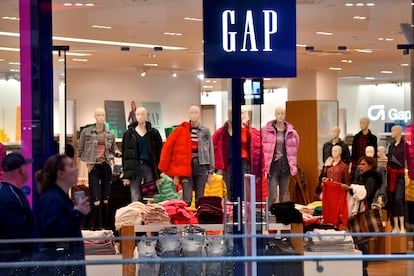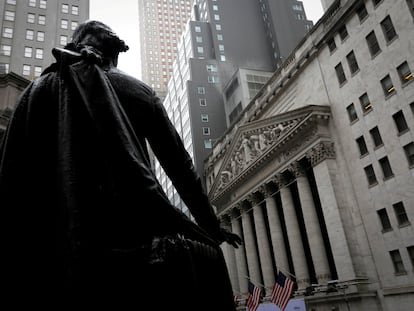How Old Navy’s inclusive sizing campaign has sent GAP into the red
The company takes a step back after a disastrous management of sizes slowed down sales


Old Navy presented its Bodequality campaign as a revolution in the world of fashion. With the help of a university professor, the company scanned the bodies of 389 women to create digital avatars of real women of all sizes. They redesigned their design and manufacturing process, interviewed hundreds of women and ran scores of tests. The inclusive campaign aimed to “democratize the shopping experience” for clothing for women of all sizes. The purpose was laudable. The result has been disastrous.
The GAP group, a fashion giant that has faced trouble due to its repeated strategic and management errors, announced this Thursday that it ended the first quarter of this fiscal year at a loss. Old Navy, its main chain, had faced a collapse in sales and margins, largely due to size management problems. The company has announced that it is taking a step back to try to recover profitability.
What happened? GAP has had many problems. But the inclusivity campaign of its Old Navy chain had an unanticipated outcome: in many stores, only very large or very small sizes of certain styles were available, while intermediate sizes were missing. When a customer makes a mistake in size, an exchange or return solves the problem. But when the company makes the mistake, and on such a large scale, the consequences are more serious.
The mix-up had multiple effects. On the one hand, the lack of merchandise in normal sizes has hampered sales. On the other hand, the excess of large sizes has caused garments to accumulate in stores. The stores have promoted aggressive sales in order to sell the remaining stock, eroding not only sales numbers but also their margins. The strategy has also completely thrown off the company’s supply chains, inventory management and response capacity. The disaster has cost Nancy Green, the Old Navy executive who launched and executed the inclusive campaign, her job.
A confession
GAP CEO Sonia Syngal openly acknowledged the problem at a conference with analysts and investors. “While we believe that BODEQUALITY is right for today’s consumer and delivers on Old Navy’s mission to democratize styles, we launched Too Broadly and Too Quickly,” she confessed. “We over-planned larger sizes with customer demand underpacing supply, leading to an excessive inventory across stores. This issue was exacerbated by out-of-stock core sizes, due to the continued supply chain disruption and inventory delays,” she continued.
She also acknowledged that putting focusing digital and physical campaigns on plus-size customers has alienated the brand’s regular customers.
Syngal has promised a thorough rectification, although it will take some time to work. The chain is cutting its offer of large sizes in physical stores to better respond to demand, while still serving customers who were drawn by the Bodequality launch.
“We’ll continue to offer the full size range online and maintain price parity across sizes in all women’s styles,” promised the GAP executive. Her team has canceled a significant portion of the large sizes for the third quarter. They are optimizing supply and will monitor demand, fine-tuning it if necessary. “We’re confident that our core sizes will be back in stock for fall,” she told analysts.
The brand’s advertising campaigns will also shift their focus away from inclusivity. The messaging has changed: “We have updated the marketing mix across channels to better reflect extended sizing as a percent of the total business and are using inspirational creative to bring back our core marketing messages of fun, fashion, family and value to the Old Navy customer.”
Lousy results
The GAP group announced Thursday night that sales for its first fiscal quarter fell by 13%, to $3.4 billion (€3.233 billion). The gross margin plunged 33% and went from representing 40.8% of sales to only 31.5%. In comparison, Inditex had a gross margin of 57.1% in 2021. The fall can be explained by the sizing issues. Despite the drop in sales, inventories have grown by 34% year-on-year, leaving a lot of merchandise to liquidate.
Despite attempts to contain spending, in that period from February to April, GAP suffered a loss of $162 million, compared to the $166 million profit of the same three months of the previous year. In addition to issues with the Old Navy brand, the sector in general is facing other obstacles, such as the increase in the cost of energy and raw materials, bottlenecks in the supply chain and the deterioration of the consumers’ spending capacity in the face of inflation. The company is raising prices on most of its brands and products.
Examining each of the company’s chains reveals that Old Navy is responsible for the entire drop in sales. It went from billing $2 billion to $1.97 billion, a drop of 19% in the brand that still represents 53% of the group’s sales. The chain that gives the group its name, GAP, reduced its turnover by 11%, to $791 million, affected by the lockdowns in China. The 24% growth of Banana Republic and the 4% growth of Athleta failed to compensate for the decline in the company’s two main brands.

The San Francisco-based group is primarily North American, although the GAP store has a more international reach. Although it is present in Europe and Asia, the group concentrates 84% of its sales in the United States and another 8% in Canada. Not even online sales have remained steady in this quarter: they have fallen by 17%, though they still represent 39% of the total.
After a difficult start to the year, the company has drastically cut its forecasts for the year as a whole. It expects net profit to be between $0.40 and $0.70 per share, compared to the range of $1.85 to $2.05 it has maintained so far. The company expects sales to fall by up to 5% for the year. The reaction of investors has been very negative, leading to decreases of more than 10% in non-market hours.
The group has 3,414 stores, including 589 franchises. Of the 2,825 company-owned stores, 1,258 are Old Navy; 840 are GAP; 496 are Banana Republic, and 231 are Athleta, its casual sportswear brand. The company plans to open between 30 and 40 Old Navy stores and as many Athleta stores in the year, but wants to close about 50 GAP stores and another 50 Banana Republic stores, as part of its plan to close 350 stores.
Tu suscripción se está usando en otro dispositivo
¿Quieres añadir otro usuario a tu suscripción?
Si continúas leyendo en este dispositivo, no se podrá leer en el otro.
FlechaTu suscripción se está usando en otro dispositivo y solo puedes acceder a EL PAÍS desde un dispositivo a la vez.
Si quieres compartir tu cuenta, cambia tu suscripción a la modalidad Premium, así podrás añadir otro usuario. Cada uno accederá con su propia cuenta de email, lo que os permitirá personalizar vuestra experiencia en EL PAÍS.
¿Tienes una suscripción de empresa? Accede aquí para contratar más cuentas.
En el caso de no saber quién está usando tu cuenta, te recomendamos cambiar tu contraseña aquí.
Si decides continuar compartiendo tu cuenta, este mensaje se mostrará en tu dispositivo y en el de la otra persona que está usando tu cuenta de forma indefinida, afectando a tu experiencia de lectura. Puedes consultar aquí los términos y condiciones de la suscripción digital.
More information
Últimas noticias
Daytime, headphones, no booze involved: How a generation is saying ‘no’ to club parties
Millennia-old Yuracaré language resists extinction through 900 speakers and a new dictionary
Susan Boyle prepares a comeback just as Timothée Chalamet sings her praises
Trump suspends green card visa lottery after shooting at Brown University
Most viewed
- Christian Louboutin: ‘Young people don’t want to be like their parents. And if their parents wear sneakers, they’re going to look for something else’
- Cartels in Mexico take a leap forward with narco-drones: ‘It is criminal groups that are leading the innovation race’
- Liset Menéndez de la Prida, neuroscientist: ‘It’s not normal to constantly seek pleasure; it’s important to be bored, to be calm’
- ‘El Limones’ and the growing union disguise of Mexican organized crime
- US sanctions against jailed cartel leader ‘El Marro’ highlight Mexico’s lack of control over its prisons









































